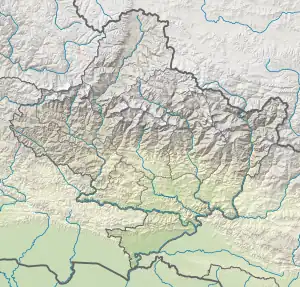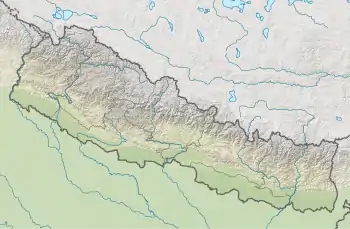Paiyun Rural Municipality
Paiyun is a Rural municipality located within the Parbat District of the Gandaki Province of Nepal. The rural municipality spans 42.65 square kilometres (16.47 sq mi) of area, with a total population of 15,381 according to a 2011 Nepal census.[1][2]
Paiyun (RM)
पैयुँ गाउँपालिका | |
|---|---|
 Paiyun (RM) Location  Paiyun (RM) Paiyun (RM) (Nepal) | |
| Coordinates: 28°02′34″N 83°39′59″E | |
| Country | |
| Province | Gandaki |
| District | Parbat |
| Wards | 7 |
| Established | 10 March 2017 |
| Government | |
| • Type | Rural Council |
| • Chairperson | Mr. Khagendra Prasad Tiwari |
| • Vice-chairperson | Mrs. Jasmati Gurung |
| • Term of office | (2017 - 2022) |
| Area | |
| • Total | 42.65 km2 (16.47 sq mi) |
| Population (2011) | |
| • Total | 15,381 |
| • Density | 360/km2 (930/sq mi) |
| Time zone | UTC+5:45 (Nepal Standard Time) |
| Headquarter | Huwas |
| Website | paiyunmun |
On March 10, 2017, the Government of Nepal restructured the local level bodies into 753 new local level structures.[3][4] The previous Huwas, Taklak, Tribeni, Behulibans, Saraukhola and Bhorle VDCs were merged to form Paiyun Rural Municipality. Paiyun is divided into 7 wards, with Huwas declared the administrative center of the rural municipality.
Demographics
At the time of the 2011 Nepal census, Paiyun Rural Municipality had a population of 15,381. Of these, 88.3% spoke Nepali, 9.1% Magar, 2.3% Gurung, 0.2% Newar and 0.1% other languages as their first language.
In terms of ethnicity/caste, 45.8% were Hill Brahmin, 22.1% Magar, 9.7% Kami, 4.5% Damai/Dholi, 4.4% Chhetri, 3.9% Gurung, 3.9% Thakuri, 2.8% Sarki, 1.6% Newar and 1.3% others.
In terms of religion, 91.2% were Hindu, 8.3% Buddhist, 0.3% Muslim, 0.1% Christian and 0.1% others.[5]
References
- "District Corrected Last for RAJAPATRA" (PDF). www.mofald.gov.np. Retrieved 17 July 2018.
- "स्थानीय तहहरुको विवरण" [Details of the local level bodies]. www.mofald.gov.np/en (in Nepali). Ministry of Federal Affairs and Local Development. Retrieved 17 July 2018.
- "New local level structure comes into effect from today". www.thehimalayantimes.com. The Himalayan Times. 10 March 2017. Retrieved 17 July 2018.
- "New local level units come into existence". www.kathmandupost.ekantipur.com. 11 March 2017. Retrieved 18 July 2018.
- NepalMap Demographics
